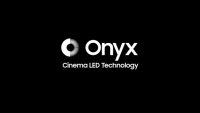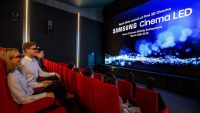Samsung Readies Onyx Cinema LED Motion Picture Screens
November 21, 2018
Last year, Samsung debuted a cinema LED screen, Onyx Cinema LED, to be offered in three sizes to accommodate different movie theaters. The 19-foot model will run at DCI 2K (2048 x 1080), and the 34-foot and 50-foot versions will run at DCI 4K (4096 x 2160). The 2K version has a peak brightness of 300 nits, and the other two support 500 nits, enabling 3D projection. The screens will support other resolutions with letterboxing as well as wide or flat DCI and several versions of HDR, including Samsung’s HDR10+.
Engadget reports that one of its reviewers was able to see a demonstration of the Onyx Cinema LED at the European film lab Éclair in Paris. “The Samsung Onyx screen is one of the most powerful pieces of equipment that allows us to display HDR content,” said Éclair general manager Pascal Mogavero. The screens are “based on its outdoor display tech that uses individual SMD (surface mount device) LEDs,” with each pixel “self-emitting with no backlight, so you can get true blacks simply by turning off individual LEDs.”

The Onyx is built by “assembling 256 x 360 pixel cabinets, each about 4 feet across,” with the smallest model using 24 cabinets and the largest 178. The result displays 16-bits of color per pixel, “and contrast ratios that match the million-to-one levels of an OLED set.”
Consistency of the image is one of its features. “We have a linear image that’s as bright in the center as it is in the edges,” said Samsung’s business development manager for cinema Paul Maloney. “Unlike a projection-based system with a lens, if you have a xenon bulb source in the center, the lens curves so the corners of the screen get darker. The same happens with color. The Samsung LED doesn’t need to be optically corrected.”
The Onyx also generates the high luminance levels required for “true HDR.” Samsung’s Harman JBL provides the Sculpted Surround Sound audio.

The reviewer calls the demo of switching one scene between SDR and HDR as “pretty eye-popping,” with colors appearing “punchy” and accurate. He adds that, “film directors and colorists will be able to optimize color timing for the screens knowing that subtle shadows will still be visible because of the extra brightness.”
On the downside, he notes that, “with the relatively low 2K resolution of the 5-meter screen, it was easy to see blocky pixels on text and angled straight lines … [which] will probably apply to the 4K displays, too.” But viewing off-angle “makes little-to-no difference in color or brightness perception, thanks again to the individual LEDs,” although he did see “a bit of blooming in a space scene where an extreme-bright area produced a halo-like artifact against a dark area.”
“Some people don’t like it because they feel it will change the filmmaker’s initial intent,” said Mogavero “If you want to show your movie on a projector, you can still do it. But if you want to completely redesign your movie and think about a completely different way to tell the stories, then you can do that, too. It’s widening, not restricting or corrupting the possibilities.”
Samsung’s plans are to install the Onyx Cinema LED in 30 locations by the end of the year.

No Comments Yet
You can be the first to comment!
Sorry, comments for this entry are closed at this time.